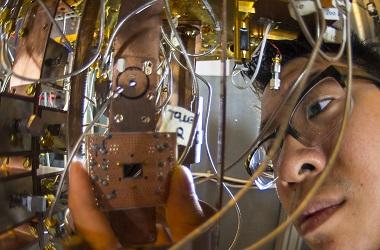Via Information week
-----
Technology giant IBM announced two major breakthroughs
towards the building of a practical quantum computer, the next evolution
in computing that will be required as Moore’s Law runs out of steam.
Described in the April 29 issue of the journal Nature Communications,
the breakthroughs include the ability to detect and measure both kinds
of quantum errors simultaneously and a new kind of circuit design, which
the company claims is "the only physical architecture that could
successfully scale to larger dimensions."
The two innovations are interrelated: The quantum bit
circuit, based on a square lattice of four superconducting "qubits" --
short for quantum bits -- on a chip roughly one-quarter-inch square,
enables both types of quantum errors to be detected at the same time.
The IBM project, which was funded in part by the
Intelligence Advanced Research Projects Activity (IARPA) Multi-Qubit
Coherent Operations program, opts for a square-shaped design as opposed
to a linear array, which IBM said prevents the detection of both kinds
of quantum errors simultaneously.
Jerry M. Chow, manager of the Experimental Quantum Computing
group at IBM’s T.J. Watson Research Center, and the primary
investigator on the IARPA-sponsored Multi-Qubit Coherent Operations
project, told InformationWeek that one area they are excited about is
the potential for quantum computers to simulate systems in nature.
"In physics and chemistry, quantum computing will allow us
to design new materials and drug compounds without the expensive
trial-and-error experiments in the lab, dramatically speeding up the
rate and pace of innovation," Chow said. "For instance, the
effectiveness of drugs is governed by the precise nature of the chemical
bonds in the molecules constituting the drug."
He noted the computational chemistry required for many of
these problems is out of the reach of classical computers, and this is
one example of where quantum computers may be capable of solving such
problems leading to better drug design.
The qubits, IBM said, could be designed and manufactured
using standard silicon fabrication techniques, once a handful of
superconducting qubits can be manufactured quickly and reliably, and
boast low error-rates.
"Quantum information is very fragile, requiring the quantum
elements to be cooled to near absolute zero temperature and shielded
from its environment to minimize errors," Chow explained. "A quantum
bit, the component that carries information in a quantum system, can be
susceptible to two types of errors -- bit-flip and phase-flip. It either
error occurs, the information is destroyed and it cannot carry out the
operation."
He said it is important to detect and measure both types of
errors in order to know what errors are present and how to address them,
noting no one has been able to do this before in a scalable
architecture.
"We are at the stage of figuring out the building blocks of
quantum computers -- a new paradigm of computing completely different
than how computers are built today," Wong said. "In the arc of quantum
computing progress, we are at the moment of time similar to when
scientists were building the first transistor. If built, quantum
computers have the potential to unlock new applications for scientific
discovery and data analysis and will be more powerful than any
supercomputer today."

